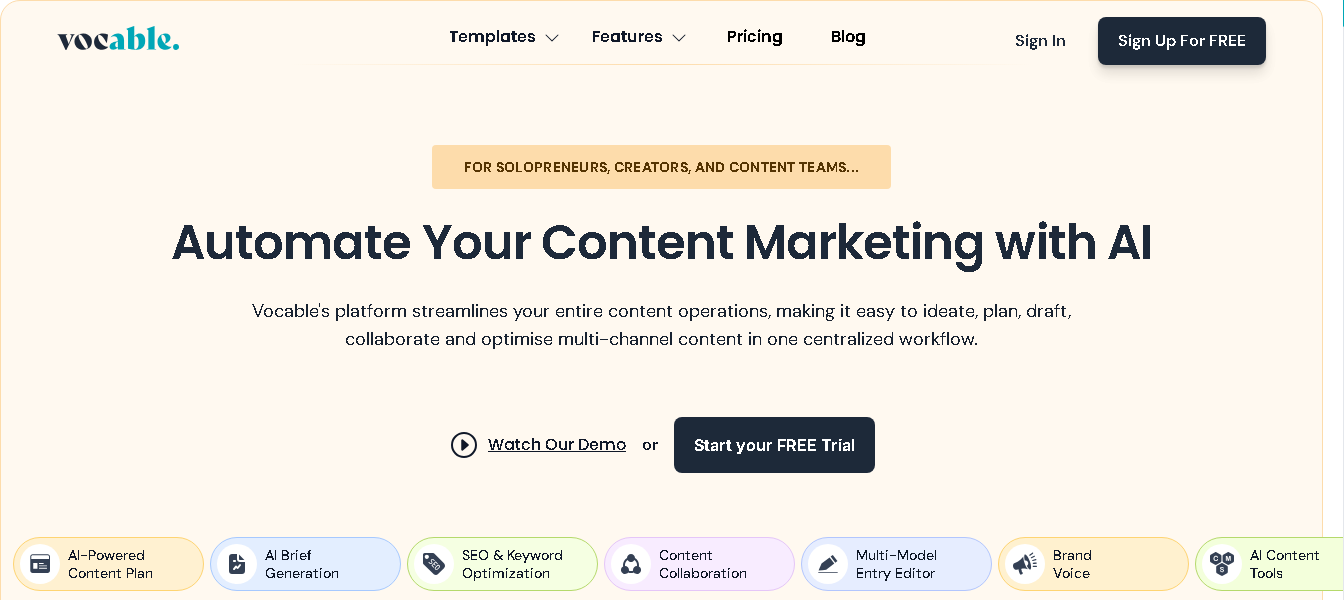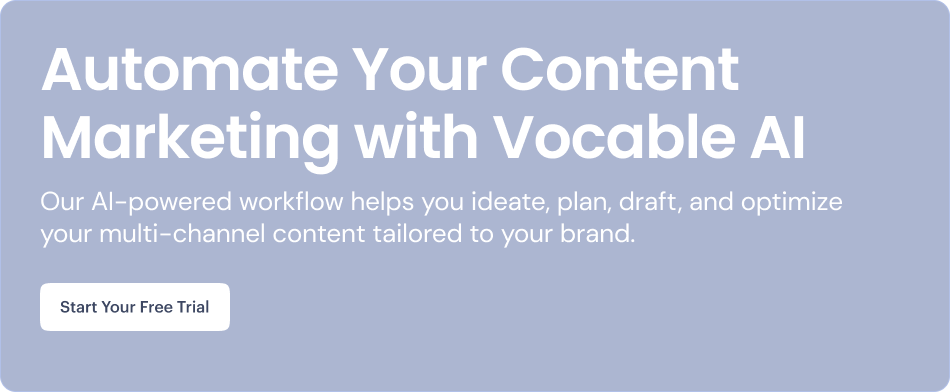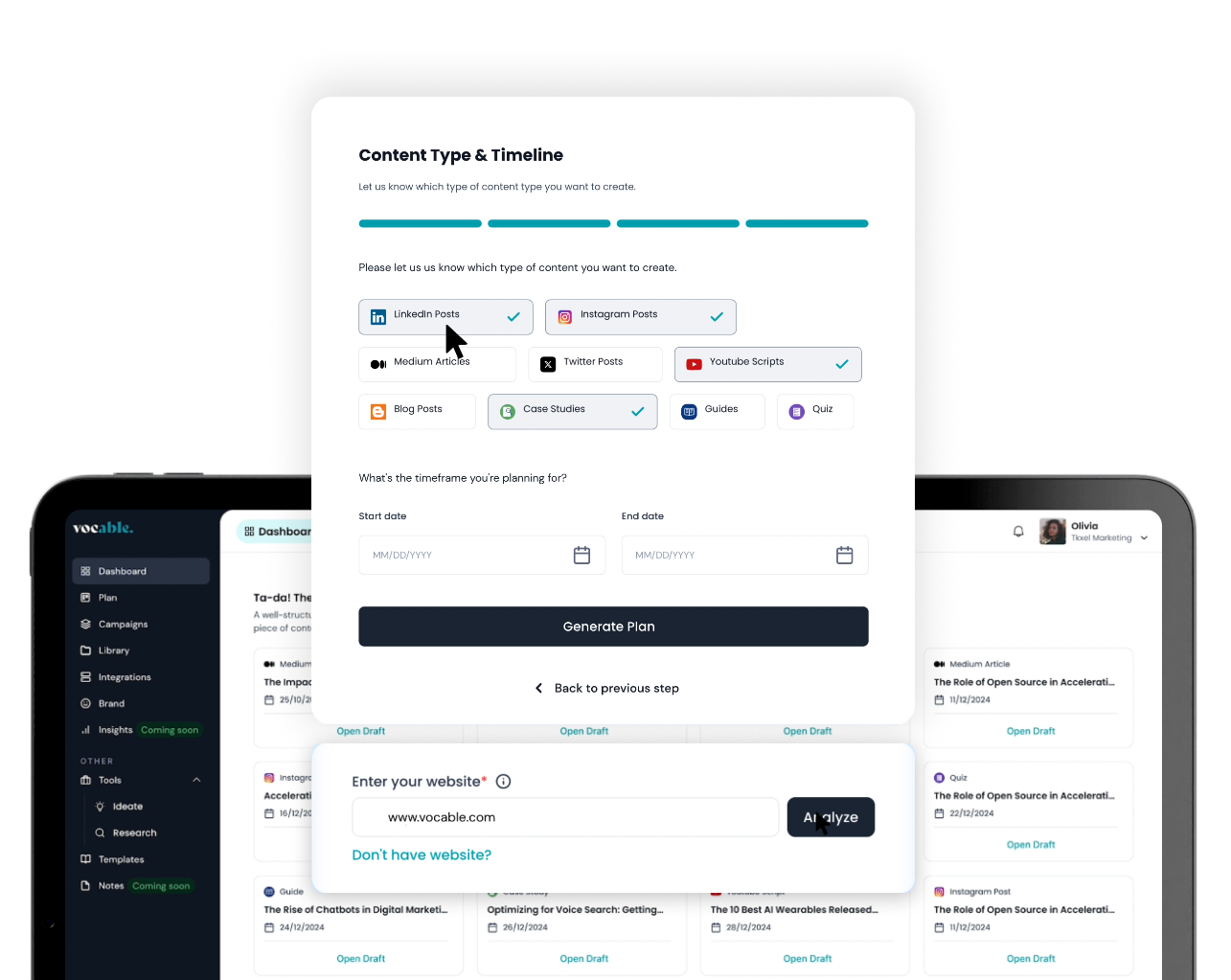7 AI Hacks Businesses Use to Scale Their Content Without Hiring a Team

Iman OubouFebruary 13, 2025 4 min read
Something interesting is happening in how small businesses create content, but not in the way many experts predicted.
After talking to dozens of small business owners and reviewing hundreds of AI-powered content campaigns, I noticed something surprising: the most successful creators aren’t using AI to replace their voice—they’re using it to boost it.
This shift isn’t happening in big corporate offices or tech labs. It’s happening in home offices and local shops. Small business owners are finding smart ways to compete with bigger companies while staying true to their voice and budget.
Before we get into the strategies, let’s address the big issue. Most advice about using AI for content marketing feels out of touch with what small business owners really face.
The usual tip—“just use AI to create more content”—misses the real challenges that business owners deal with every day.
Let’s talk about how to actually use AI to scale your content.
The Reality Check
Last month, I sat down with Rachel, a therapist who built a thriving practice in Seattle but struggled to maintain a consistent online presence.
“Everyone told me to ‘just use AI’ for my blog,” she told me, rolling her eyes. “But generic mental health content is worse than no content at all. My readers need to feel the empathy and expertise that brought them to my practice in the first place.”
Rachel’s experience highlights a crucial insight: the goal isn’t to produce more content—it’s to create content that actually moves the needle for your business.
Through my conversations with small business owners and my own experiments with platforms like Vocable.ai, I’ve identified patterns that separate successful AI-enhanced content strategies from those that fall flat.
The Patterns That Matter
The first big aha moment is figuring out that AI is better at helping your creativity, not replacing it. When you let AI write entire articles, the content usually turns out pretty dull. But the smart move? Use AI to spark ideas and make your process faster while keeping your own voice front and center.
Take David, a financial advisor whose newsletter regularly outperforms larger competitors. “I used to spend hours organizing my thoughts before writing,” he explained during our interview.
“Now I use AI to help structure my ideas and research market trends, but the insights and analysis come from my 20 years of experience. The technology helps me work smarter, not just faster.”
This pattern repeats across industries: successful AI adoption isn’t about replacement—it’s about enhancement. The technology works best when it handles the time-consuming aspects of content creation while leaving space for human expertise and personality to shine through.
The Tools That Work
Through my research and hands-on testing, I’ve identified seven specific strategies that consistently deliver results for small businesses.
But these aren’t your typical “use AI to write more blogs” tips. These are practical approaches that acknowledge the real constraints and challenges of running a small business.
Let’s be clear about something: most AI-generated content fails because it lacks the very things that make content valuable—genuine insight, authentic voice, and real expertise.
The strategies I’m about to share flip this dynamic on its head, using AI to amplify rather than replace these crucial elements.
7 Strategies to Scale Your Content Using AI
These are the strategies:
Strategy 1: Contextual Content Enhancement
The first breakthrough in AI-powered content creation comes from understanding how modern language models can enhance rather than replace human expertise.
Through my analysis of successful small business content strategies, a pattern emerges: the most effective approaches use AI not as a replacement for human insight but as a tool for expanding and refining ideas.
During a recent workshop in Austin, I watched a local bakery owner transform her content strategy using this approach. Instead of asking AI to generate generic recipes or blog posts, she used it to explore variations of her unique sourdough technique, generating dozens of angles she hadn’t considered.
The resulting content wasn’t just more extensive—it was richer in detail and more aligned with her expertise.
Strategy 2: Adaptive Research Synthesis
One of the biggest changes in content creation is how AI is shaking up research and idea generation. The old way of researching usually leads to shallow insights that just repeat existing content that’s already out there.
But after watching how successful creators use AI, I’ve noticed something deeper and much more interesting happening.
Take the case of a Portland-based woodworker whose Instagram following grew from 3,000 to 50,000 in six months. His secret wasn’t just creating more content—it was using AI to identify unexplored intersections between traditional craftsmanship and modern design sensibilities.
The technology helped him spot patterns in audience engagement that would have been impossible to detect manually.
Strategy 3: Content Velocity Optimization
The conventional wisdom about content frequency—”post more, get more engagement”—falls apart under scrutiny. Through analyzing content performance across different industries, I’ve observed a more nuanced reality: success comes from finding the right rhythm for your specific audience and content type.
A Denver coffee shop owner demonstrated this perfectly. Instead of flooding social media with AI-generated posts, she used the technology to identify optimal posting patterns based on her customers’ behaviors.
The result? Higher engagement with less content, proving that timing and relevance trump pure volume.
Strategy 4: Semantic Intent Mapping
One of the most powerful yet underutilized capabilities of modern AI systems is their ability to understand audience intent. This goes beyond simple keyword research—it’s about understanding the underlying questions and needs driving your audience’s behavior.
I witnessed this transformation firsthand with a small law firm in Chicago. By analyzing patterns in client questions and concerns, they developed content that addressed specific legal anxieties before clients even articulated them.
Their website traffic increased 300% in four months, but more importantly, their consultation requests doubled.
Strategy 5: Multi-Format Content Synthesis
The future of small business content isn’t just about writing—it’s about building a connected experience across different formats.
From what I’ve seen and researched, the businesses that really get AI right aren’t just cranking out more content. They’re creating smarter content that fits together and works across multiple platforms.
A local fitness trainer in Miami exemplifies this approach. Instead of creating separate content for different platforms, she uses AI to help adapt her core expertise into various formats—workout videos, nutrition guides, motivation posts—while maintaining a consistent voice and message across all channels.
Strategy 6: Predictive Engagement Analysis
After digging into successful content strategies, I noticed a clear pattern. What sets high-performing content apart is the ability to predict how the audience will engage and tweak the content before it even goes live.
A small bookstore in Seattle provides a perfect example. By analyzing customer behavior patterns and purchase history, they used AI to predict which book recommendations would resonate with different customer segments. The result? A 40% increase in online sales and significantly higher engagement on their newsletter.
Strategy 7: Authentic Voice Amplification
The final and most important strategy is knowing how AI can boost your authentic voice instead of watering it down. This matters a lot for small businesses, where that personal touch gives you an edge over bigger competitors.
A Texas-based career coach demonstrated this beautifully. Instead of using AI to generate generic career advice, she used it to help structure and expand upon her unique insights, maintaining her distinctive voice while significantly increasing her content output.
Implementation Strategy for Small Businesses
The secret to making these strategies work is knowing there’s no single approach that fits everyone.
After speaking with successful small business owners and reviewing my research, I’ve noticed a clear way to implement them effectively:
Voice Preservation
Your voice makes your content unique. Keep that personal touch.
- Define your style – What tone and perspective make your content yours?
- Know your strengths – Identify what draws your audience in.
- Set AI boundaries – Use AI for support, but stay in control.
Build Your Enhancement System
Start small and let AI help improve your content.
- Focus on one content type – Like blogs or emails.
- Refine, don’t replace – Use AI to polish your ideas.
- Monitor feedback – Adjust based on audience response.
Scale Thoughtfully
Expand when you’re ready while staying consistent.
- Add new formats – Try social media or video next.
- Stay true to your voice – Keep it real and authentic.
Create Consistent, On-Brand Content at Scale with Vocable

Vocable simplifies content creation, helping your team collaborate, create, and optimize content effortlessly—all in one place.
From idea generation to publishing, Vocable’s AI-powered tools streamline every step, saving time and boosting productivity.
With built-in SEO, autogenerated briefs, and real-time collaboration, scaling your content strategy has never been easier.
Transform how your team works. Create high-quality, on-brand content at scale.
Try Vocable now and take your content to the next level!
FAQs About Using AI to Scale Content
Is it legal to use AI content?
Yes, AI-generated content is legal if it follows copyright laws and stays accurate. Many businesses use AI tools for content creation to connect with their target audience while maintaining content quality and brand voice.
Can you rank AI content?
AI-generated content can rank if it’s relevant and optimized for your target audience. Combining AI tools with a good content creation process improves content quality and boosts marketing efforts across channels.
What is AI scaling?
AI scaling means using AI tools to boost content production. It helps scale content creation, automate content repurposing, and reach multiple marketing channels faster, supporting business growth while keeping content quality high.
How to use AI in digital transformation?
Generative AI simplifies digital transformation by automating the content creation process and scaling content production. Businesses can produce relevant content, automate content repurposing for marketing channels, create engaging social media posts, and grow faster without sacrificing quality.
Get Started with Vocable
Master every aspect of Vocable, from automated content planning to publishing in these step-by-step tutorials and product guides.
Get Started Now





